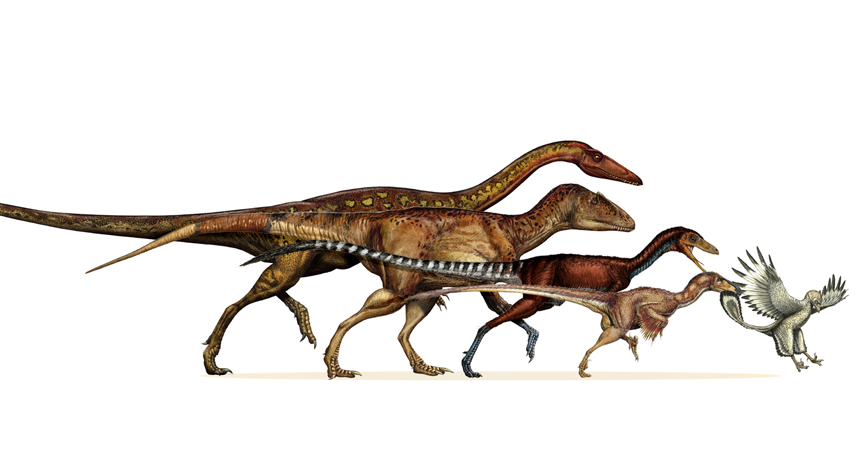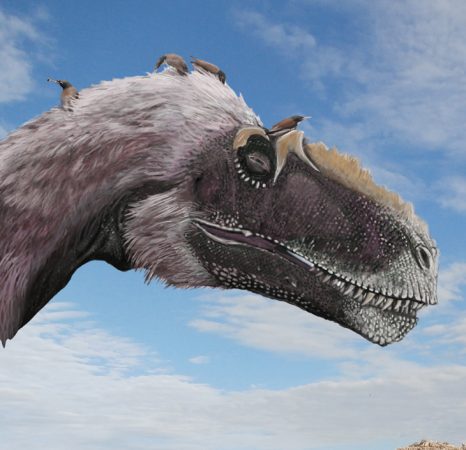Dinos ‘quickly’ shrunk into birds
This steady miniaturization led some dinosaurs to find ways to better adapt for the long-term survival of their line

The dinosaur ancestors of birds shrank steadily for more than 50 million years. Left to right: a neotheropod (from about 220 million years ago), a tetanuran, a coelurosaur, a paravian and finally Archaeopteryx (from 150 million years ago).
Davide Bonnadonna
Dinosaurs were the original incredible shrinking animals. For more than 50 million years, they became steadily smaller. At the same time, their bodies rapidly morphed in other ways as well. By the end, these massive animals had transformed into relatively tiny ones: birds.
This is the conclusion of a new analysis of bones, feathers and teeth from 120 dinosaur species. In the Aug. 1 Science, scientists describe the string of adaptive changes and shrinkages that led to birds.
Scientists already knew birds evolved from dinosaurs. Yet no one quite understood precisely how and when the shrinking occurred — or how quickly it progressed, notes Michael Lee, an author of the new study. As a paleontologist at the South Australian Museum and the University of Adelaide, he studies the fossil remains of ancient organisms.

Other efforts to pin down dino-evolution rates had tended to focus on just one or two fossil features. For instance, they might look at changes in the relative lengths of legs or wings. Lee’s team took a far broader look. It focused on theropods. These were the meat-eating, walking-on-two-legs dinosaurs that led to birds.
Altogether, the scientists cataloged 1,549 separate body features. These included the shapes of teeth, bones and skulls. The scientists also looked at feather types and where on the body those feathers grew.
Borrowing statistical tools typically used in genetics, the researchers built a detailed family tree for the theropods. They used fossils to date when various features changed on branches of the tree. This work provided evidence of how long it took the bodies of successive dino species to change.
Roger Benson, a paleontologist at the University of Oxford in England, is impressed by what Lee’s team did. “The scale of this study is unprecedented,” he says. Its authors “looked across the whole skeleton.”
The birds’ dino ancestors evolved skeletal adaptations roughly four times as fast as did other dinosaurs, including T. rex, Velociraptor and Allosaurus. Lee concludes that “Birds and their ancestors were out-evolving all the other dinosaurs that were running around.”
And the trend was quite consistent. Every species on the route that would lead to birds was smaller than the one before it, the team found. Lee thinks small body size let some theropods explore and adapt to new environments and lifestyles.
“If you’re large, there are only a few things you can do,” he says. “You basically just lumber around.” But once the ancestors of birds started shrinking, Lee says, “they could start climbing trees. They could start experimenting with gliding and leaping. And ultimately they started flying.”
This video illustrates the changes that occurred as dinosaurs shrank — and morphed into birds. Credit: Michael Lee
Power Words
allosaurs (also known as allosauroids) A group of two-legged, meat-eating dinosaurs named for one of its oldest species, Allosaurus.
fossil Any preserved remains or traces of ancient life. There are many different types of fossils: The bones and other body parts of dinosaurs are called “body fossils.” Things like footprints are called “trace fossils.” Even specimens of dinosaur poop are fossils.
paleontologist A scientist who specializes in studying fossils, the remains of ancient organisms.
theropod A meat-eating dinosaur of a group whose members are typically bipedal (walk on two legs) and range from small and delicately built to very large.
tyrannosaurid Any of the large, two-footed therapod tyrannosaurs living in the Cretaceous Period. This included Tyrannosaurus rex, a top-predator from the late Cretaceous. Adults of this species could be 12 meters (40 feet) long.







